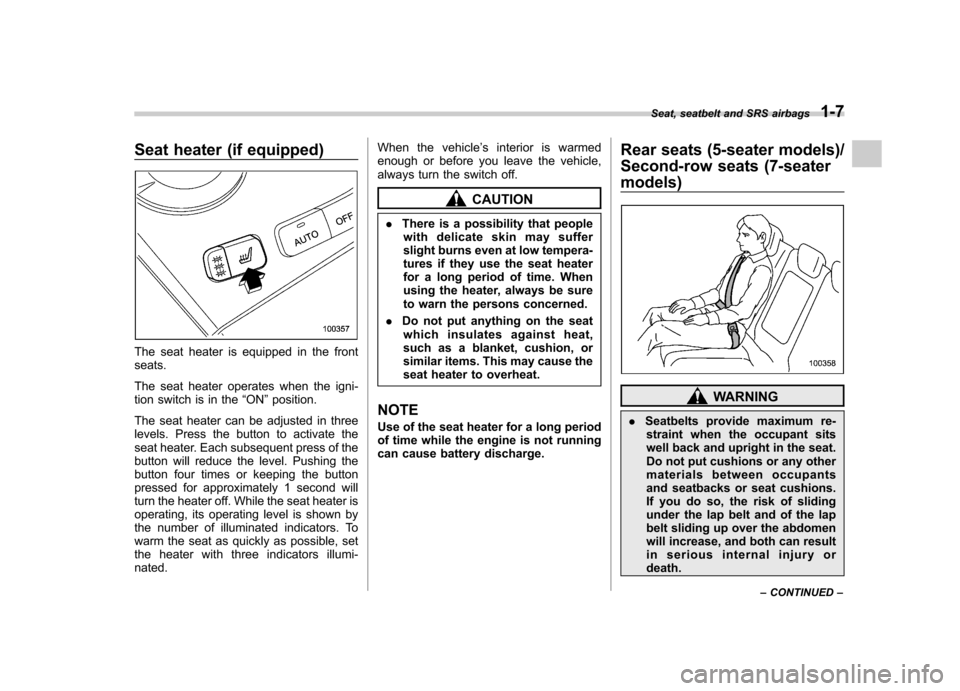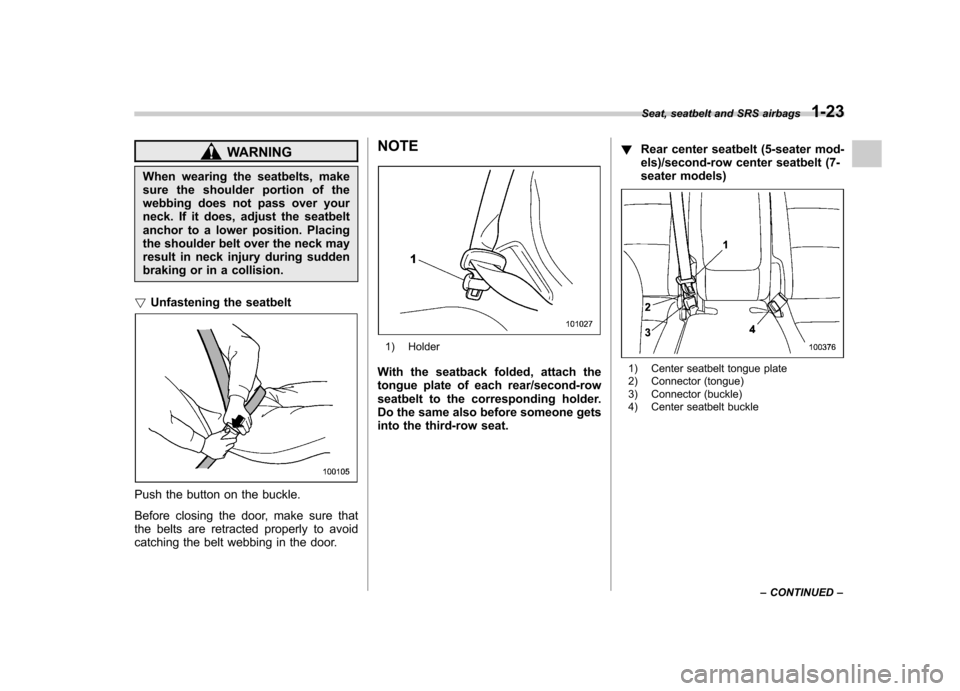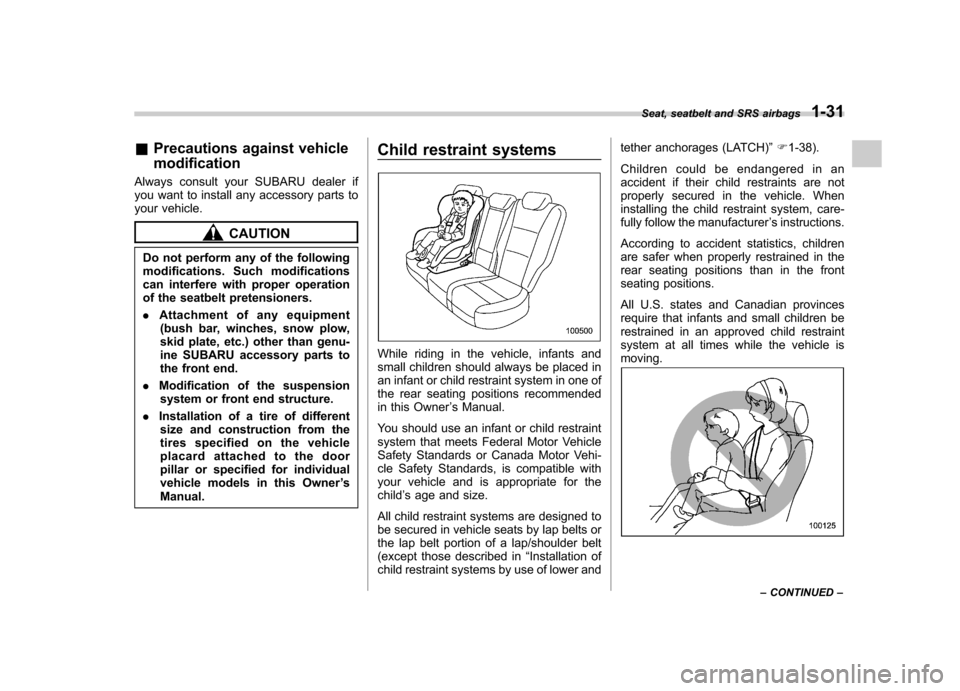2010 SUBARU TRIBECA ECO mode
[x] Cancel search: ECO modePage 25 of 422

22
Function settings
A SUBARU dealer can change the settings of the functions shown in the following table to meet your personal requirements. Contact
the nearest SUBARU dealer for details. If your vehicle is equipped with the genuine SUBARU navigation system, the settings for some
of these functions can be changed using the navigation monitor. For details, please refer to the Owner’s Manual supplement for the
navigation system.
Item Function Possible settings Default setting Page
Alarm system Alarm system Operation/Non-operation Operation 2-16
Monitoring start delay time (after closure of doors) 0 second/30 seconds 30 seconds 2-17
Impact sensor operation (only models with shock
sensors (dealer option)) Operation/Non-operation Non-operation 2-20
Passive arming Operation/Non-operation Non-operation 2-19
Dome light/map lights illumination ON/OFF OFF 2-16
Remote keyless entry sys- tem Hazard warning flasher Operation/Non-operation Operation 2-8
Audible signal
Operation/Non-operation Operation 2-11
Key lock-in prevention Key lock-in prevention Operation/Non-operation Operation 2-7
Remote engine start system
(dealer option) Horn chirp confirmation ON/OFF ON 7-10
Rear window defogger Rear window defogger Operation for 15 minutes/ Continuous operationOperation for 15 minutes 3-37
Windshield wiper deicer Windshield wiper deicer Operation for 15 minutes/ Continuous operationOperation for 15 minutes 3-36
Map lights/Dome light Operation of map lights/dome light OFF delay timer OFF/Short/Normal/Long Normal 6-2/6-3
Map lights Illumination in conjunction with a door open Operation/Non-operation Operation (Illumination - ON)6-3
Battery drainage prevention function Battery drainage prevention function Operation/Non-operation Operation 2-6
Page 28 of 422

Front seats........................................................... 1-2
Power seat .......................................................... 1-3
Memory function (driver ’s seat –if equipped) ....... 1-4
Head restraint adjustment .................................... 1-5
Active head restraint ........................................... 1-6
Lumbar support .................................................. 1-6
Seat heater (if equipped) .................................... 1-7
Rear seats (5-seater models)/Second-row seats (7-seater models) ................................... 1-7
Forward and backward adjustment ...................... 1-8
Reclining the seatback ........................................ 1-9
Folding down the seatback ................................. 1-10
Head restraint adjustment ................................... 1-11
Armrest ............................................................. 1-13
Third-row seat (7-seater models) ...................... 1-13
Access to the third-row seat ............................... 1-13
Folding down the seatback ................................. 1-14
Head restraint adjustment ................................... 1-15
Seatbelts ............................................................. 1-16
Seatbelt safety tips ............................................. 1-16
Emergency Locking Retractor (ELR) ................... 1-18
Automatic/Emergency Locking Retractor (A/ELR) ............................................................ 1-18
Seatbelt warning light and chime ........................ 1-18Fastening the seatbelt
........................................ 1-19
Seatbelt maintenance ......................................... 1-28
Front seatbelt pretensioners ............................. 1-28
System monitors ............................................... 1-29
System servicing ............................................... 1-30
Precautions against vehicle modification ............ 1-31
Child restraint systems ..................................... 1-31
Where to place a child restraint system .............. 1-32
Choosing a child restraint system ...................... 1-34
Installing child restraint systems with A/ELR seatbelt ........................................................... 1-34
Installing a booster seat ..................................... 1-37
Installation of child restraint systems by use of lower and tether anchorages (LATCH) .............. 1-38
Top tether anchorages ....................................... 1-41
*SRS airbag (Supplemental Restraint System airbag) ................................................ 1-45
Your vehicle ’s SRS configuration ....................... 1-45
SUBARU advanced frontal airbag system ........... 1-49
SRS side airbag and SRS curtain airbag ............. 1-60
SRS airbag system monitors .............................. 1-71
SRS airbag system servicing ... .......................... 1-72
Precautions against vehicle modification ............ 1-72
Seat, seatbelt and SRS airbags1
Page 34 of 422

Seat heater (if equipped)
The seat heater is equipped in the front seats.
The seat heater operates when the igni-
tion switch is in the“ON ”position.
The seat heater can be adjusted in three
levels. Press the button to activate the
seat heater. Each subsequent press of the
button will reduce the level. Pushing the
button four times or keeping the button
pressed for approximately 1 second will
turn the heater off. While the seat heater is
operating, its operating level is shown by
the number of illuminated indicators. To
warm the seat as quickly as possible, set
the heater with three indicators illumi-nated. When the vehicle
’s interior is warmed
enough or before you leave the vehicle,
always turn the switch off.
CAUTION
. There is a possibility that people
with delicate skin may suffer
slight burns even at low tempera-
tures if they use the seat heater
for a long period of time. When
using the heater, always be sure
to warn the persons concerned.
. Do not put anything on the seat
which insulates against heat,
such as a blanket, cushion, or
similar items. This may cause the
seat heater to overheat.
NOTE
Use of the seat heater for a long period
of time while the engine is not running
can cause battery discharge. Rear seats (5-seater models)/
Second-row seats (7-seater
models)
WARNING
. Seatbelts provide maximum re-
straint when the occupant sits
well back and upright in the seat.
Do not put cushions or any other
materials betwe en occupants
and seatbacks or seat cushions.
If you do so, the risk of sliding
under the lap belt and of the lap
belt sliding up over the abdomen
will increase, and both can result
in serious internal injury ordeath. Seat, seatbelt and SRS airbags
1-7
– CONTINUED –
Page 40 of 422

&Armrest
To lower the armrest, pull on the strap of
the armrest.
WARNING
To avoid the possibility of serious
injury, passengers must never be
allowed to sit on the center armrest
while the vehicle is in motion. Third-row seat (7-seater models)WARNING
Seatbelts provide maximum re-
straint when the occupant sits well
back and upright in the seat. Do not
put cushions or any other materials
between occupants and seatbacks
or seat cushions. If you do so, the
risk of sliding under the lap belt and
of the lap belt sliding up over the
abdomen will increase, and both can
result in serious internal injury ordeath.
WARNING
Never stack luggage or other cargo
higher than the top of the seatback
because it could tumble forward and
injure passengers in the event of a
sudden stop or accident.
& Access to the third-row seat
There are levers on both sides of the
second-row seat. Each lever is used to
facilitate access to the third-row seat.
WARNING
In its slid-forward position with the
seatback tipped forward, the sec-
ond-row seat is not locked and free Seat, seatbelt and SRS airbags
1-13
– CONTINUED –
Page 49 of 422

1-22Seat, seatbelt and SRS airbags
! Rear seatbelts (5-seater models)/
Second-row seatbelts (7-seatermodels) –excluding center seatbelt
1. Sit well back in the seat.
2. Pick up the tongue plate and pull the
belt out slowly. Do not let it get twisted. If
the belt stops before reaching the buckle,
return the belt slightly and pull it out more
slowly. If the belt still cannot be unlocked,
let the belt retract slightly after giving a
strong pull on it, then pull it out slowlyagain.
3. Insert the tongue plate into the buckle
until you hear a click.
4. To make the lap part tight, pull up on
the shoulder belt.
5. Place the lap belt as low as possible
on your hips, not on your waist. !
Adjusting the shoulder belt anchor
height (rear seats of 5-seater mod-
els/second-row seats of 7-seatermodels)
The shoulder belt anchor height should be
adjusted to the position best suited for the
passenger. Always adjust the anchor
height so that the shoulder belt passes
over the middle of the shoulder without
touching the neck.
To raise:
Slide the anchor up.
To lower:
Push the release button and slide the
anchor down.
Pull down on the anchor to make sure that
it is locked in place.
Page 50 of 422

WARNING
When wearing the seatbelts, make
sure the shoulder portion of the
webbing does not pass over your
neck. If it does, adjust the seatbelt
anchor to a lower position. Placing
the shoulder belt over the neck may
result in neck injury during sudden
braking or in a collision.
! Unfastening the seatbelt
Push the button on the buckle.
Before closing the door, make sure that
the belts are retracted properly to avoid
catching the belt webbing in the door. NOTE
1) Holder
With the seatback folded, attach the
tongue plate of each rear/second-row
seatbelt to the corresponding holder.
Do the same also before someone gets
into the third-row seat. !
Rear center seatbelt (5-seater mod-
els)/second-row center seatbelt (7-
seater models)
1) Center seatbelt tongue plate
2) Connector (tongue)
3) Connector (buckle)
4) Center seatbelt buckleSeat, seatbelt and SRS airbags
1-23
– CONTINUED –
Page 57 of 422
![SUBARU TRIBECA 2010 1.G Owners Manual 1-30Seat, seatbelt and SRS airbags
.Satellite safing sensor (under the rear
center seat [5-seater models] / under the
second-row center seat [7-seater models]) . Seatbelt pretensioner (driver ’s si SUBARU TRIBECA 2010 1.G Owners Manual 1-30Seat, seatbelt and SRS airbags
.Satellite safing sensor (under the rear
center seat [5-seater models] / under the
second-row center seat [7-seater models]) . Seatbelt pretensioner (driver ’s si](/manual-img/17/7324/w960_7324-56.png)
1-30Seat, seatbelt and SRS airbags
.Satellite safing sensor (under the rear
center seat [5-seater models] / under the
second-row center seat [7-seater models]) . Seatbelt pretensioner (driver ’s side)
. Seatbelt pretensioner (front passen-
ger ’s side)
. Seatbelt buckle switch (driver ’s side)
. Seatbelt buckle switch (front passen-
ger ’s side)
. Driver ’s seat position sensor
. Front passenger ’s seatbelt tension
sensor. Front passenger ’s occupant detection
system weight sensor. Front passenger ’s occupant detection
control module . Front passenger ’s frontal airbag ON
and OFF indicator . All related wiring
WARNING
If the warning light exhibits any of
the following conditions, there may
be a malfunction in the seatbelt
pretensioners and/or SRS airbag
system. Immediately take your vehi-
cle to your nearest SUBARU dealer
to have the system checked. Unless
checked and properly repaired, the
seatbelt pretensioners and/or SRS airbags will operate improperly (e.g.
SRS airbags may inflate in a very
minor collision or not inflate in a
severe collision), which may in-
crease the risk of injury. .
Flashing or flickering of the warn-
ing light
. No illumination of the warning
light when the ignition switch is
first turned to the “ON ”position
. Continuous illumination of the
warning light
. Illumination of the warning light
while driving
& System servicing
WARNING
. When discarding a seatbelt re-
tractor assembly or scrapping
the entire vehicle damaged by a
collision, consult your SUBARU
dealer.
. Tampering with or disconnecting
the system ’s wiring could result
in accidental activation of the
seatbelt pretensioner and/or air-
bag or could make the system
inoperative, which may result in serious injury. Do not use elec-
trical test equipment on any
circuit related to the seatbelt
pretensioner and airbag sys-
tems. For required servicing of
the seatbelt pretensioner, see
your nearest SUBARU dealer.
CAUTION
The front sub sensors are located
on both sides of the radiator panel,
and the airbag control module in-
cluding the impact sensors is lo-
cated under the center console. If
you need service or repair in those
areas or near the front seatbelt
retractors, we recommend that you
have an authorized SUBARU dealer
perform the work.
NOTE
If the front part of the vehicle is
damaged in an accident to the extent
that the seatbelt pretensioner does not
operate, contact your SUBARU dealer
as soon as possible.
Page 58 of 422

&Precautions against vehicle modification
Always consult your SUBARU dealer if
you want to install any accessory parts to
your vehicle.
CAUTION
Do not perform any of the following
modifications. Such modifications
can interfere with proper operation
of the seatbelt pretensioners. . Attachment of any equipment
(bush bar, winches, snow plow,
skid plate, etc.) other than genu-
ine SUBARU accessory parts to
the front end.
. Modification of the suspension
system or front end structure.
. Installation of a tire of different
size and construction from the
tires specified on the vehicle
placard attached to the door
pillar or specified for individual
vehicle models in this Owner ’s
Manual. Child restraint systems
While riding in the vehicle, infants and
small children should always be placed in
an infant or child restraint system in one of
the rear seating positions recommended
in this Owner
’s Manual.
You should use an infant or child restraint
system that meets Federal Motor Vehicle
Safety Standards or Canada Motor Vehi-
cle Safety Standards, is compatible with
your vehicle and is appropriate for thechild ’s age and size.
All child restraint systems are designed to
be secured in vehicle seats by lap belts or
the lap belt portion of a lap/shoulder belt
(except those described in “Installation of
child restraint systems by use of lower and tether anchorages (LATCH)
”F 1-38).
Children could be endangered in an
accident if their child restraints are not
properly secured in the vehicle. When
installing the child restraint system, care-
fully follow the manufacturer ’s instructions.
According to accident statistics, children
are safer when properly restrained in the
rear seating positions than in the front
seating positions.
All U.S. states and Canadian provinces
require that infants and small children be
restrained in an approved child restraint
system at all times while the vehicle ismoving.
Seat, seatbelt and SRS airbags 1-31
– CONTINUED –